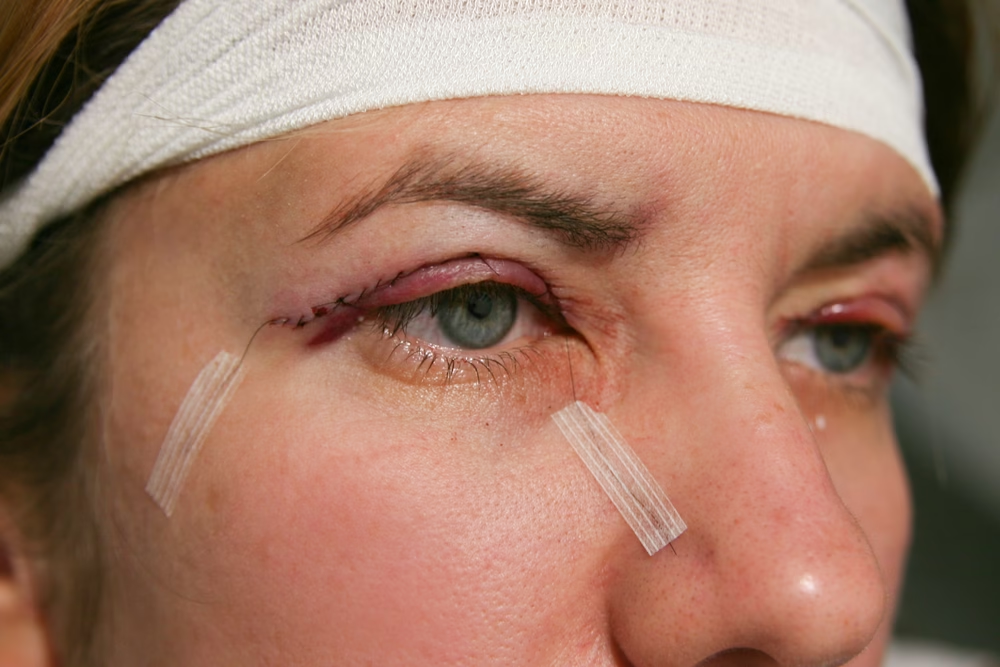Eyelid surgery, or blepharoplasty, is one of the most refined and transformative cosmetic procedures, designed to rejuvenate your appearance and restore youthful vitality. But what if, even 2 months after blepharoplasty, swelling lingers? Should you be concerned, or is this just part of the healing process?
Dr. Viral Desai, a renowned cosmetic and plastic surgeon in Mumbai, has helped countless patients navigate post-surgical recovery with precision and care. Swelling, while expected, can sometimes persist due to various underlying factors. Understanding these reasons, and knowing how to manage them effectively, can make all the difference in achieving flawless results.
Let’s explore the answers to your most pressing questions.

Is It Normal to Have Swelling Two Months After Blepharoplasty?
Yes—and no. While most patients experience significant improvement in swelling within 4 to 6 weeks, some may notice residual puffiness even at the two-month mark. This isn’t necessarily a cause for concern, but there are nuances to consider.
- Morning puffinessis common due to fluid retention and gravity’s effect on circulation.
- Mild firmness or tightnessin the eyelids is expected as internal healing progresses.
- Subtle asymmetrymay persist as tissues continue to settle into their final position.
But beware— if you experience worsening swelling, vision problems or pain after blepharoplasty, it’s time to take a closer look.
Expert Insight from Dr. Viral Desai:
“Your eyes are one of the most delicate structures in your body. Post-surgical swelling isn’t just about external healing—it’s about how your lymphatic system, circulation, and collagen production respond. Patients who rush recovery often compromise their final results. Healing is an art in itself.”
Still experiencing discomfort or unusual swelling?
Consult a proficient cosmetic surgeon to discuss your concerns and ensure a smooth recovery.
Causes of Prolonged Swelling After Blepharoplasty
Every individual’s healing timeline is unique, but several common factors contribute to lingering swelling 2 months after blepharoplasty.
1. Lymphatic Drainage Slowdown
- After surgery, the lymphatic system may still be regenerating and struggling to clear excess fluid efficiently.
- This can lead to persistent puffiness, especially around the lower eyelids.
2. Inflammatory Response
- Your body naturally triggers low-grade inflammation as part of the healing process.
- Factors like stress, poor diet, or lack of sleep can amplify swelling and delay recovery.
3. Scar Tissue Formation & Internal Healing
- Although scars may look fully healed externally, internal tissue remodeling continues for months.
- Tiny adhesions or fibrotic tissue can trap fluid and cause swelling.
4. Fat Redistribution & Structural Adjustments
- If fat grafting or repositioning was performed, swelling can persist as the body adapts.
- The final contours of the eyes may take up to 6 months to fully stabilize.
5. Lifestyle Triggers
- Salty foods, alcohol, dehydration, and poor sleeping habits all contribute to fluid retention.
- Hormonal fluctuations can also impact swelling, especially in women.
Expert Perspective:
“Patients often focus on external recovery, but true healing happens at a cellular level. Your body is constantly adjusting, and small changes in your daily habits—like reducing sodium intake and ensuring deep sleep—can dramatically speed up recovery.” – Dr. Viral Desai
How to Reduce Swelling 2 Months After Blepharoplasty
If you’re still experiencing swelling after blepharoplasty, it’s time to take action with these proven strategies:
1. Master the Art of Lymphatic Massage
- A gentle, sweeping massage around the eyes can improve circulation and drainage.
- Use light fingertip pressure and avoid excessive force.
2. Cold Therapy (But in Moderation)
- Apply a cool—not icy—compress for 5–10 minutes daily.
- Extreme cold can constrict vessels too much, worsening swelling.
3. Optimize Your Sleeping Position
- Sleeping with your head elevated reduces fluid buildup overnight.
- Avoid sleeping on your side or stomach, which can redistribute swelling unevenly.
4. Nourish Your Body for Faster Healing
- Increase hydration and consume anti-inflammatory foods like turmeric, pineapple (bromelain), and green tea.
- Reduce processed foods and excess sodium to prevent fluid retention.
5. Limit Screen Time & Reduce Eye Strain
- Long hours of screen exposure can lead to eye fatigue and delayed healing.
- Follow the 20-20-20 rule: Every 20 minutes, look 20 feet away for 20 seconds.
Pro Tip:
“Think of recovery as a luxury retreat for your skin. The more you pamper it with hydration, rest, and nourishment, the faster it will thank you with stunning results.” – Dr. Viral Desai
Ready to reverse signs of aging and regain confidence?
Experience the power of precision cosmetic surgery—restore youthful, natural beauty with a procedure tailored to you.
When to Contact Your Surgeon
Red Flags You Shouldn’t Ignore
If you experience any of the following symptoms, schedule an urgent consultation:
- Increasing or worsening swellingthat doesn’t improve.
- Sudden pain, redness, or heat around the eyes.
- Vision disturbances, blurriness, or difficulty opening your eyelids.
- Lumps, hard tissue, or uneven contours that persist.
Conclusion – Patience Yields Perfection
Swelling two months after blepharoplasty is often just a sign that your body is still fine-tuning the results. By understanding why it happens, practicing proper aftercare, and making smart lifestyle adjustments, you can accelerate your recovery and achieve the beautiful, refreshed look you envisioned.
However, if swelling is worsening or affecting your quality of life, never hesitate to consult an expert. With Dr. Viral Desai’s guidance, your healing journey will be smooth, predictable, and tailored for optimal results.
Noticing any unusual symptoms?
Don’t delay—consult a reliable cosmetic expert to address your concerns promptly.
Frequently Asked Questions:
How long does it take for blepharoplasty swelling to go down?
Can swelling be permanent after blepharoplasty?
Recovery typically allows resumption of normal activities within 10 to 14 days post-surgery. Adherence to post-surgical care is crucial to minimize the risk of complications and promote healing. Residual swelling is expected to diminish over the weeks post-eyelid surgery.
When is blepharoplasty fully healed?
Most people feel comfortable going out in public after 10 to 14 days. But it can take a few months to heal completely. During your blepharoplasty recovery, you can use cold compresses and antibiotic ointment to ease any swelling.
Reference
https://www.plasticsurgery.org/cosmetic-procedures/eyelid-surgery
https://www.mayoclinic.org/tests-procedures/blepharoplasty/about/pac-20385174
Disclaimer: The information shared in this content is for educational purposes only and not for promotional use.


